Recently, the Deep Silver Dambuster Studio’s Audio Team embarked on a spooky old field recording expedition to two of the creepiest places in Nottingham – The Galleries of Justice Museum and The City of Caves. Here’s a spooktacular rundown of what we got up to…
Why the Galleries of Justice & Nottingham Caves?
We chose these locations as they are dripping with dark atmospherics - we wanted to be able to transfer this essence into the scarier parts of our game. From the cramped claustrophobic ancient prison cells to the dank darkness of the caves, we’ve managed to capture the chilling horror of the location’s audio DNA in order to embed an unsettling authenticity into our soundscape. Where possible, we always want to create bespoke atmospheres for our projects and the Caves and the Galleries of Justice seemed like the perfect opportunity to do so.
The Galleries of Justice Museum

[The team about to commence recording on the execution steps]
We started the day following in the footsteps of those condemned to a grizzly fate at Nottingham’s County Gaol. Until the abolishment of public executions in 1868, the steps outside the Galleries of Justice were also the site of multiple hangings (and that’s before you’ve even entered the building!)
The site houses a dock in which the accused stood to hear their fate. After this, they spent their final hours Imprisoned in tiny cells down below the dock before finally being escorted to the execution courtyard. Here, they were hanged from a set of gallows until they were dead. (The justice museum also separately houses Britain’s last working gallows). It’s sobering to imagine the dread convicts must have felt to go through this process. Other scary exhibits in the building consist of leg-irons, ghoulish force-feeding equipment and a history of embattled truncheons utilised to keep prisoners ‘’compliant”.
The Dock
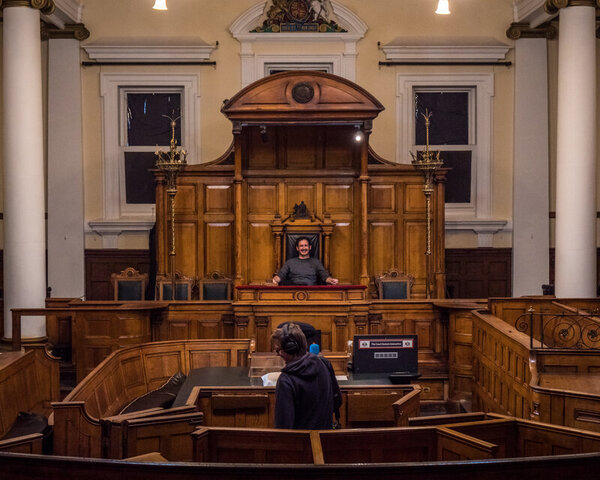
[Recording Impulse responses in the dock]
The configuration of the dock grants it a unique sonic characteristic, which surprisingly contains the room’s natural reverb well. Speech carries easily across the space but is somewhat dampened by the positioning of the wood (presumably to aid the clarity of verdicts given out by justice officials). Here we captured more impulse recordings, which we will use to emulate similar sized rooms within the game.
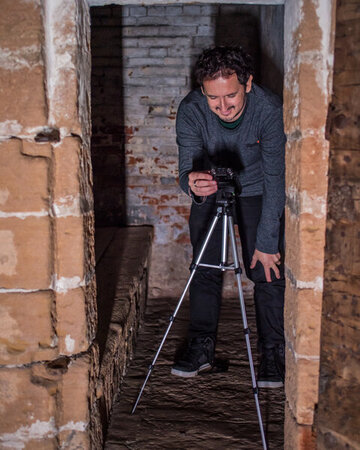
[Ryan Williams awaiting his fate in the underground cells]
The cells
As you can imagine, the cells are of a rudimentary design but served us well in emulating the sound of close-up claustrophobic spaces. The arches in the room give off lively resonant overtones, which we noticed when popping balloons to create our custom reverbs. We took two recording setups into the locations and decided to split into two groups concentrating on capturing different aspects of the spaces. One group focused on recording ambience related content and the other looked at capturing onsite foley opportunities.
The process
For our recordings, we chose to concentrate on four key areas.
- Capturing impulse responses in order to create custom reverbs
- Capturing room tones
- Worldising existing in-game content
- Foley capture.
Capturing impulse responses in order to create custom reverbs

[Setting up in the Galleries of Justice Museum foyer]
Upon ascending the execution steps and entering the interior, you are greeted by a large foyer hall which was “spotted” on an initial scouting trip for having a suitably creepy long reverb time. Here we captured several impulse responses using three different methods.
- Generated Sinewaves played back through speakers in the space (three versions – four seconds, eight seconds and 32 seconds) – These are later sent through a deconvolving process to provide unique sonic reverb “maps” of the room.
- Hand claps
- Balloon pops
Each of these are processed differently and can be used to create realistic sounding reverb spaces which can be applied to any sound within our game. With this method, we can make the assets sound “embedded” into a certain location. We can also increase the wetness levels or reverb length in game to make our environments sound extra spooky.
Capturing room tones
For the spaces in the Galleries and Caves we recorded room tones. They are important to capture the “base level” sound of a space when creating an environment. They will serve as the bed of an area in order to achieve realism. Often room tones consist of very subtle elements such as the whirr of air conditioning units or gentle traffic noise obscured by windows or walls. This process helps to embed a natural sound into our game’s interior spaces.
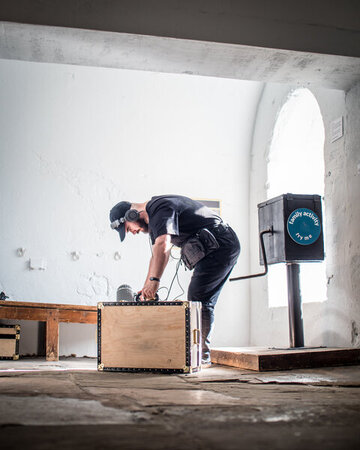
“Worldising” existing in-game content
Another method we used was to take existing sounds we have already created and play them through speakers inside various spaces. We then re-record those sounds inside the real-world spaces in order to embed even more realism into the audio. As an example of what is possible, we can take dry creature sounds and make them sound distant by re-recording the audio from around a corner or through some sort of audio obstruction. These “reverb baked” effects can be useful for spot effects that are triggered in game and give us a wider palette of sounds to choose from.
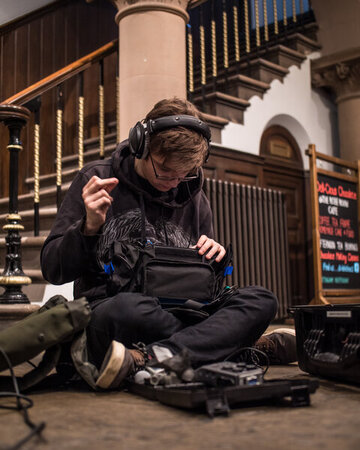
[Matt Lightbound getting “Heavy on the gain”]
Foley capture
Currently serving as museums, both the galleries and the caves own several unique historical items, which we were given access to operate and manipulate in order to capture sounds useful for foley. We captured a multitude of slamming cell doors, fantastically clunky locks and chilling leg chains actually used to enslave prisoners way back when. Additionally, we conducted as many scrapes, bumps, bangs, scratches, and drags as the onsite staff would let us get away with!
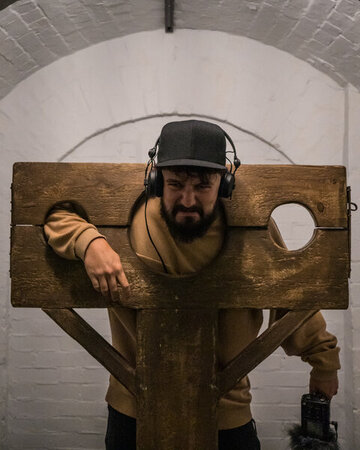
Our equipment setup:
• Zoom F8 field recorder
• Tascam DR100Mk III (x2)
• Zoom F6 field recorder
• 8XLRs
• Mics
• Behringer NTG4 Shotgun Mics (Contained inside custom modified Rode Blimp)
• Laptop – for content playback
• One large bag of party balloons!
The setup was designed to be mobile as we knew we had to record in several spaces throughout the Galleries and Caves. Our method was a reasonably swift run and gun style as we only had a few hours in each of the locations. We were lucky to have multiple hands on deck and our pre-planning paid dividends in terms of getting the best coverage of each space.
City of Caves
The latter half of the day saw us descending into the darkness of the City of Caves. They are part of a large network of over 500 caves underneath Nottingham, which go all the way back to the dark ages. They ooze with spooky atmosphere and originated as habitable dwellings as early as the 11th century.
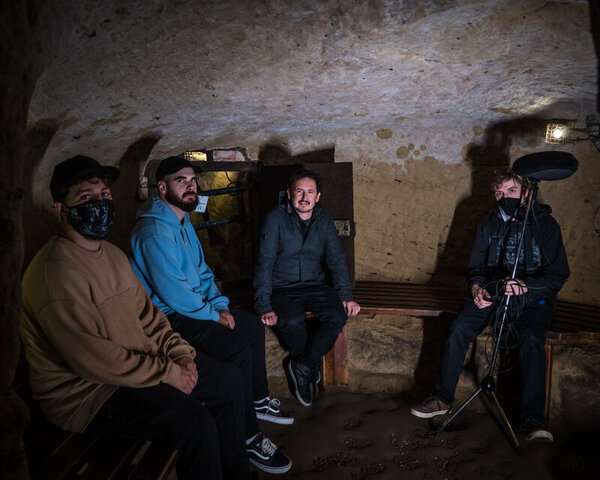
[The penny drop room – Used for warning nefarious cave dwellers that the authorities were on their way.]
The City of Caves consist of a circular route which takes you through several sandstone areas underneath the Broadmarsh center. The soft sandstone formation gives the caves a significant dampening effect to recordings (echo reflections are next to minimal) which meant we instead concentrated on distanced worldising techniques for weapons and creatures.
The claustrophobic effect of the caves is prevalent in our audio captures and the largest Tannery space only reflects a most humble slap into our audio recorders. We can use the closeness to really make our players feel unnerved when listening to the ambiences in our game. The porous nature of the sandstone allows water to pass through, which gifted us some trickling water sounds as the rain poured above our heads.
The route through the caves begins its conclusion by presenting a wartime version of itself in which the space was utilised as an air raid shelter for the citizens of Nottingham. We recorded assets from many props from the wartime era including authentic gas mask vocalisations and fire bells from that bygone era. We then travelled through the bombed-out, blitz era representation of local Nottingham slums and finally back up to the daylight… And breathe.
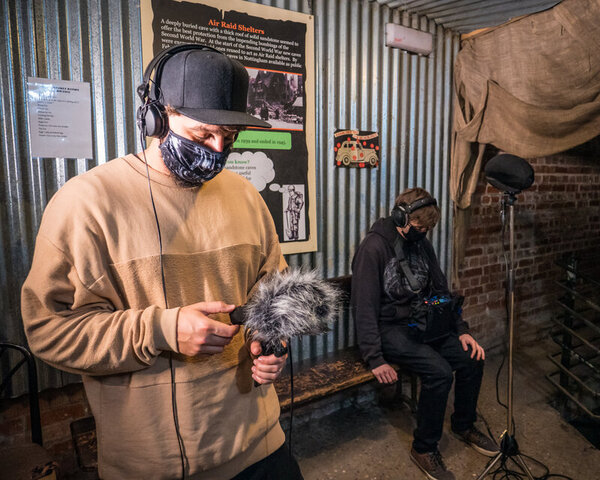
The Result
It was a privilege to be allowed to capture all the spaces inside of these dark locations, uninhibited by everyday background noise and bustle. Reflecting on our time in the Galleries of Justice, it sends a chill through me to think the site was the location of so many executions, deaths and gruesome acts in the name of justice. If you are a fan of Nottingham’s dark history, I would recommend spending some time in both locations to imagine the horror the condemned individuals underwent. For our current project, I can’t imagine a more perfect place in which to unleash our field recorders to capture the sound of the grim, the ghoulish and the ghastly.
Many thanks to Lauren Sulley and Jess Clarke at the Justice museum for letting us rampage across both sites and fulfilling all our requests.
Also, a huge thanks to Phil Hunter from Hunter Films who did an amazing job of documenting the day for us.
All photo credits go to Phil. Check out his awesome Instagram: hunter_films_photography
This blog was written by Ryan Williams – Audio Designer at Dambuster Studios.




